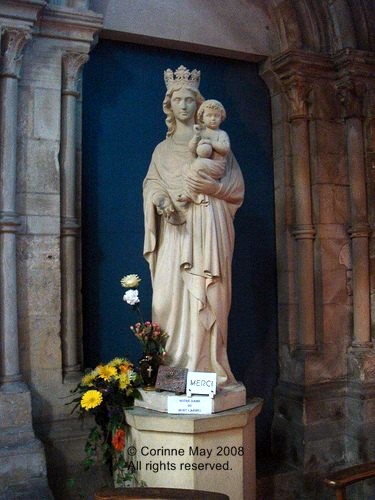Saint Therese of the Child Jesus
of the Holy Face
Entries in Sister Martha of Jesus (3)
125 years ago with St. Therese: July 16, 1895: "Prayer to Jesus in the Tabernacle" for Sister Martha of Jesus
"Prayer to Jesus in the Tabernacle" of St. Therese of Lisieux: July 16, 1895

The statue of Our Lady of Mount Carmel before which Pauline Martin was praying in St. Jacques Church in Lisieux on February 16, 1882 when she understood that she was called to Carmel. This statue is now in st. Pierre's Cathedral in Lisieux. My thanks to Corinne May for the photo.
Sister Martha of Jesus
In the Lisieux Carmel, July 16, 1895 was not only the feast of Our Lady of Mount Carmel but also the 30th birthday of Sister Martha of Jesus, a lay-sister eight years older than Therese who had entered Carmel about three months before Therese. They had spent their time of formation together. Sister Martha became so attached to Therese that she asked to stay in the novitiate permanently so that she might continue to benefit by Therese's good advice.
The "Prayer to Jesus in the Tabernacle"
Therese wrote the "Prayer to Jesus in the Tabernacle" as a birthday present for Sister Martha. The lay-sisters, who got up even earlier than the other nuns and did much of the community's domestic work, were not obliged to stay up for Matins. Sister Martha was the community's hard-working cook. Her day ended with a visit to the Blessed Sacrament at about 8:00 p.m. In this visit she included her examination of conscience, and the editors of The Prayers of Saint Therese of Lisieux point out that the text suggests that she had asked Therese for a prayer to help in this examination.
This prayer, written soon after Therese's "Offering of myself as a victim of holocaust to the Merciful Love of God," is important to understanding Therese and has, I believe, been somewhat overlooked to date.1 Thanks to the generosity of the Washington Province of Discalced Carmelites and the Web site of the Archives of the Carmel of Lisieux, you can read it online. Yet, because the introduction and the notes, which do not appear online, contribute much to our understanding of Sister Martha and of the prayer, I strongly recommend consulting the volume The Prayers of Saint Therese of Lisieux.
Sister Martha, who had lost her mother at age four, spent her childhood in two different orphanages, and lost her father when she was no more than twelve, was marked all her life by the lack of maternal affection and of a stable early home. Despite a sincere devotion, she found it hard to live peacefully with those around her. Therese acknowledges the faults this sister will have to confront on many evenings:
If I were more united to You, more charitable with my sisters, more humble and more mortified, I would feel less sorrow when I talk with you in prayer.
Yet, in a personal Theresian note, "very far from becoming discouraged, I come to you with confidence." The line "I beg You to act in me despite my resistance" speaks to the spirit of contradiction with which Sister Martha had to contend. Therese assures her boldly that on "the last evening of my life" she will reach at once "the unending day of eternity, when I will place in your Divine Heart the struggles of exile!" This conviction that those who trust in love will go straight to heaven, which, as we have seen, marked Therese in a conversation with Sister Febronie before the latter's death in 1892, seems to find more frequent expression starting in 1895.
Sister Martha's later life
Therese's relationship with Sister Martha is vital to a full understanding of Therese and of her life in the community, and I hope to examine it further. Despite her lack of formal education, Sister Martha was an important witness at both processes, speaking simply and in rich detail of what she observed in Therese during the nine years they spent together. Happily, in the end Sister Martha received the grace of the confidence Therese modeled for her. Before her death at age 51, she received the last sacraments on August 28, 1916. She said:
During the ceremony I felt the presence of our little saint. It was like a heavenly voice that said in my ear, “You too, if you wish in spite of your poor life, you can go straight to heaven” and I understood that the greatest sinner could obtain this grace through confidence and humility.2
May the companion for whom Therese wrote this prayer draw us all to the same bold confidence that brought Sister Martha to the Divine Heart.

Footnotes:
1. The autograph of the prayer was destroyed; we have only a copy, which was fortunately made to be submitted to the Process of Therese's writings before the autograph was burned. Most of Sister Martha's private papers were burned after her death to prevent tuberculosis from spreading in the monastery. See Sainte Therese de l'Enfant Jesus et de la Sainte-Face, Correspondance generale, T. 1 (Paris: Editions du Cerf and Desclee de Brouwer, 1992), p. 68, footnote 46. Most unfortunately, this bonfire consumed other notes from Therese which had not been submitted to the Process. No one copied them before destroying the oriiginals. An oral tradition in the Lisieux Carmel maintains that some of the novices received many more notes from Therese than they contributed to the Process. Sister Martha, however, included the text of this prayer in her oral testimony before the diocesan process. That some of Therese's other notes to her were burned is a serious loss to the archive of Therese's correspondence.
 2. http://www.archives-carmel-lisieux.fr/english/carmel/index.php/les-novices/marthe-de-j%C3%A9sus/biographie, accessed July 16, 2020.
2. http://www.archives-carmel-lisieux.fr/english/carmel/index.php/les-novices/marthe-de-j%C3%A9sus/biographie, accessed July 16, 2020.
125 years ago with St.Therese: "Song of Gratitude to Our Lady of Mount Carmel," July 16, 1894
 July 16, 1894 was the 26th birthday of Sister Martha of Jesus, a lay-sister who entered three months before Therese. This birthday furnished the occasion for Therese's seventh poem, "Song of Gratitude to Our Lady of Mount Carmel." The poem takes its inspiration from the circumstances of Sister Martha's life.
July 16, 1894 was the 26th birthday of Sister Martha of Jesus, a lay-sister who entered three months before Therese. This birthday furnished the occasion for Therese's seventh poem, "Song of Gratitude to Our Lady of Mount Carmel." The poem takes its inspiration from the circumstances of Sister Martha's life.
One of the best ways to understand Therese's way is to get to know the women with whom she lived in Carmel. Learn more about the young woman who lived close to Therese for nine years:
On the feast of St. Therese of Lisieux, Pope Francis praises her example, “which makes the people say: we want to come with you!” Video from Romereports, October 1, 2013
This morning, concelebrating Mass in his residence, the Domus Sanctae Marthae, with the eight cardinals he selected in April to counsel him about reforming the governance of the Roman Curia, Pope Francis held up St. Therese of Lisieux as a model to the Cardinals, praying that “our work today will make us all more humble, more gentle, more patient, more trusting in God.”
Pope Francis reflected on today’s gospel: the apostles asked Jesus whether they might call down fire from heaven on those who did not welcome them. The Pope said that the Christian way is not a way of vengeance, but instead the way of humility and gentleness.
The Pope noted that today is the feast of St. Therese of the Child Jesus, whose life calls everyone to “think about this spirit of humility, of tenderness, of goodness. It is a spirit that the Lord wants from all of us. Where, then, is the power that brings us to this spirit? It is found in love, in charity, in the awareness that we are in the hands of the Father. With this awareness one will not want “to call down fire from Heaven.”
“Another spirit comes, that of that charity that suffers all, pardons all, that does not boast, that is humble, that doesn’t seek itself. Someone could say — and there are some philosophers that think this way — that this is a humiliation of the majesty of man, of the greatness of man. This is sterile! The Church has wisely made this saint, humble, small, trusting in God, gentle: she has made her the Patron of Missions."
The strength of the Gospel is there “because the Gospel reaches its highest point in the humiliation of Jesus: humility that becomes humiliation. And the force of the Gospel, he said, is properly in humility, in the humility of the child that is guided by the love and the tenderness of the father.
The Church, Benedict XVI told us, does not grow through proselytism, it grows through attraction, through witness. And when the people see this witness of humility, of gentleness, of mildness, they feel the need that the Prophet Zachariah spoke of: ‘We want to come with you.’ The people feel that need in the face of the witness of charity, of this humble charity, without bullying, not sufficient, humble. Worship and serve! Charity is simple: worship God and serve others! And this witness makes the Church grow.” That’s why a nun, so humble, but so trusting in God, a nun like St. Therese of the Child Jesus was named Patron of the Missions, because of her example which makes “the people say ‘we want to come with you!’”
Today, here in the Vatican, begins the meeting with the Cardinal consulters, who are concelebrating the Mass. Let us ask the Lord that our work today will make us all more humble, more gentle, more patient, more trusting in God, so that the Church can give a beautiful witness to the people, and seeing the People of God, seeing the Church, they might feel the desire to come with us.”
[The above is based on a summary of the Pope’s remarks from Romereports]
* * * * *
Pope Francis’s homily echoes Therese in several different ways. His line “because the Gospel reaches its highest point in the humiliation of Jesus: humility that becomes humiliation” recalls the “Prayer to obtain humility” Therese wrote for Sister Martha of Jesus, a lay-sister who had some difficulty letting the other nuns order her about:
Now in the Sacred Host I see you at the height of your annihilations. How humble you are, O divine King of Glory, to subject yourself to all your priests without making any distinction between those who love you and those who are, alas! lukewarm or cold in your service... At their word you come down from heaven. Whether they advance or delay the hour of the Holy Sacrifice, you are always ready O my Beloved, how gentle and humble of heart You seem under the veil of the white Host! To teach me humility you cannot humble yourself further.
Read the full text of St. Therese's "Prayer to obtain humility" at to see how Therese understood the humility Pope Francis praises.
The importance Therese attached to being humble is also at the center of her “pious recreation” (a short play she wrote to be acted at a feast-day recreation) “The Triumph of Humility,” which ends
Fervent Carmelites, you desire
To gather heartsw for Jesus, your Spouse.
Then stay forever little for Him.
Humility puts hell in a rage.
Pope Francis speaks about attraction:
The Church, Benedict XVI told us, does not grow through proselytism, it grows through attraction, through witness. And when the people see this witness of humility, of gentleness, of mildness, they feel the need that the Prophet Zachariah spoke of: ‘We want to come with you.’
Therese writes about her spiritual attraction:
When a soul allows herself to be captivated [5] by the odor of your ointments, she cannot run alone, all the souls whom she loves follow in her train; this is done without constraint, without effort, it is a natural consequence of her attraction for You. Just as a torrent, throwing itself with impetuosity into the ocean, drags after it everything it encounters in its passage, in the same way, [10] O Jesus, the soul who plunges into the shoreless ocean of Your Love, draws with her all the treasures she possesses.
Sister Martha of Jesus testifies about her attraction to Therese:
Indeed, had I followed my natural inclination, I would often have avoided going to her for guidance, because I knew she would tell me my faults. But her holiness attracted me so strongly that I went to her almost in spite of myself.
What would the Church look like if it were renewed in the image of St. Therese, as Pope Francis prayed this morning?